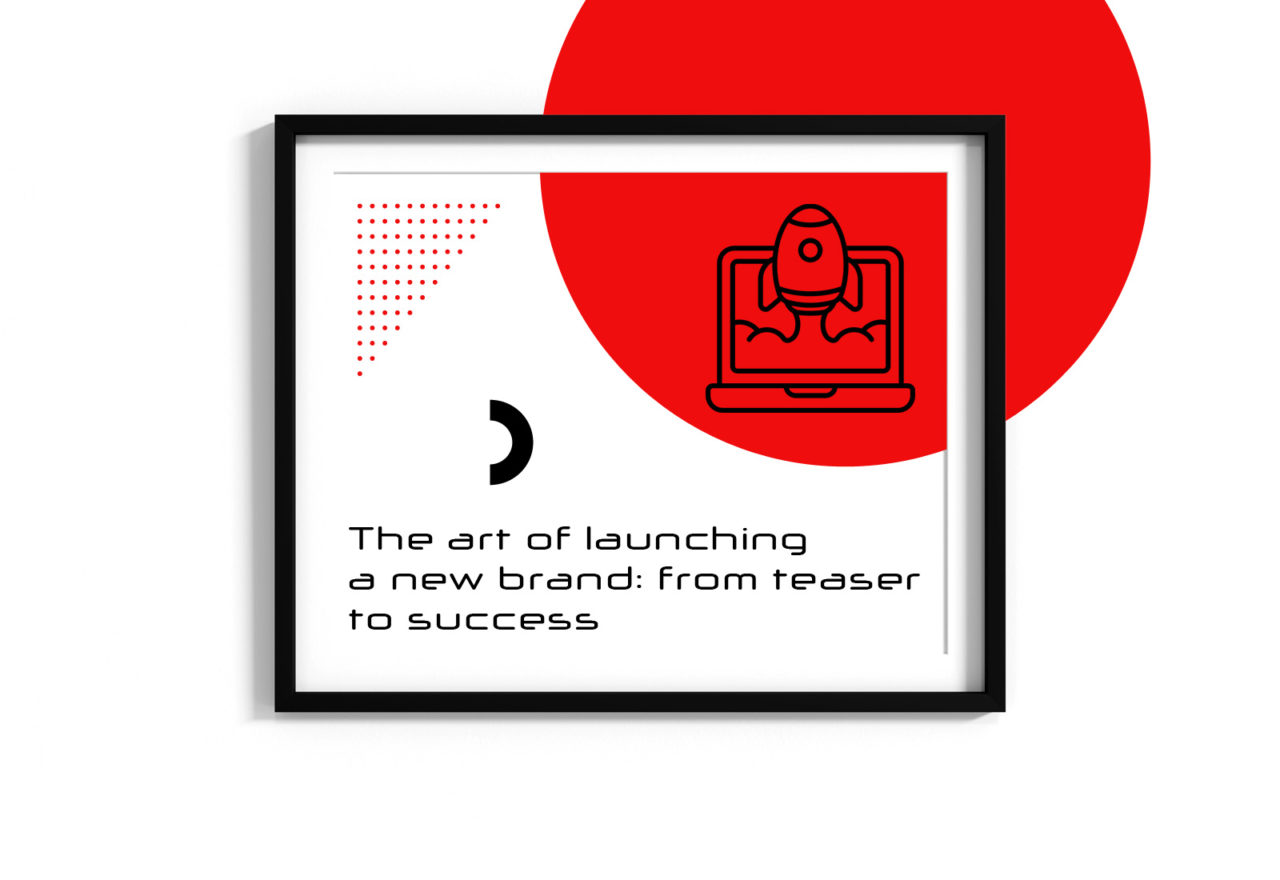The art of launching a new brand: from teaser to success
Launching a new brand is an exciting but challenging process that can be a key moment in the company’s future success. At this point, the company has a chance to earn its place in the minds of consumers and differentiate itself in the competitive marketplace. It’s a task full of challenges, but also opportunities. This process requires proper preparation, knowledge and experience.That is why outsourcing the activities to a marketing agency can bring a lot of advantages and be the key to success.
An experienced advertising agency knows the market realities, is able to correctly identify the expectations of the target group and, on this basis, proposes the direction of building a new brand and introducing it to the market.
Table of Contents:
- Market and competitive research
- Market trends
- SWOT analysis
- Brand identification
- Teaser – introduction to the mystery
- Launch Campaign
- 8 steps of the launch campaign
- Community Building
- The most important aspects of community building
- Working with specialists
- Advantages of working with a marketing agency
Market and competitive research
Before beginning the process of launching a new brand, it is important to conduct a thorough market and competitive analysis. Market research helps us understand current industry trends, key competition, and perceived gaps or needs in the marketplace. This is the foundation upon which we build our brand launch strategy.
Competition research involves identifying and analyzing companies already operating in a particular industry or market segment. This means getting to know the key players, understanding their offerings and marketing tactics, and identifying their strengths and weaknesses. Competitive analysis can help determine how a brand can differentiate itself in the marketplace and what market gaps or niches can be exploited.
Market trends
Markets are dynamic and trends can change quickly. Market trend research involves identifying current and future trends in the industry. This can include analyzing changes in consumer behavior, new technologies, regulatory requirements, or social trends. This allows you to adapt your marketing strategy to the current needs and expectations of the market.
SWOT analysis
SWOT analysis is a tool that allows you to identify your brand’s strengths, weaknesses, opportunities and threats in the marketplace. This helps to develop a strategy that leverages the brand’s strengths and minimizes risks.
Market and competitive research is not just about gathering data, but transforming it into specific conclusions and strategies. It is a process that provides key information on which you can build an effective brand launch strategy. Therefore, it is a stage that should not be skipped, and it is worth entrusting it to professionals in a marketing agency who have the appropriate tools and experience in conducting such analyses.
The next step is to define the goals we want the new brand to achieve and the values it should represent. Do you want the brand to be perceived as innovative, ecological, luxurious or affordable? Identifying these aspects will allow you to focus on the appropriate courses of action. This brings us to the next point, which is creating brand identification.

Brand identification
Now it’s time to create a brand image. What’s underneath? The name, the tagline and, of course, the visuals: logo, colors, typography, website, social media profiles, tone of communication, initial collateral. A consistent and attractive brand image is crucial to building brand recognition.
Brand identification is the process of defining what exactly a particular brand should be and what values and characteristics it should represent:
- Values and mission: This is a key element of brand identification that needs to be defined;
- Brand personality: What is the brand like? Should it be friendly, eco-friendly, luxurious, serious and professional, or perhaps something else? Determining this “personality” allows you to communicate consistently with customers and build relationships;
- Vocabulary and tone: The choice of vocabulary and tone of communication is important in building a consistent brand image. It determines how the brand will be perceived by customers;
- Logo and visual identity: This is obviously an important part of the brand identity. Designing logos, colors, fonts, and other visual elements that will represent the brand. All of these elements should be consistent and reflect the brand’s identity;
- Brand history: Many brands have a history. What the brand’s roots, origins and evolution are can be part of its identification. A brand’s story can create an emotional connection with customers;
- Values statement: Can include ethical principles, social commitment, or other values important to the company.
Identifying these aspects will allow you to focus on appropriate courses of action. When implementing and using visual brand identification, it is important to remember how strongly visual factors influence the recipient.
Teaser – introduction to the mystery
A teaser campaign is a type of advertisement or announcement designed to interest and intrigue the audience without revealing full information about the product or brand. This tool can be extremely effective when introducing a new brand to the market.

Examples of teasers include mysterious promotional videos, cryptic social media posts, or enigmatic posters. Their purpose is to intrigue, interest, and excite future customers before the brand’s official launch.
A teaser campaign often begins with the release of cryptic, short pieces of information or images that do not reveal the full message. The purpose of this is to capture the imagination and spark the curiosity of the audience. In subsequent phases, additional elements or information are gradually revealed, building the narrative around the news and revealing more and more details, while still maintaining a certain level of mystery.
The key element here is to create mystery and build anticipation. Recipients should be intrigued and wonder what exactly is behind this mysterious campaign. This can encourage them to actively follow and engage with your marketing content. It is also worth including a newsletter subscription to keep interested parties up to date.
A teaser campaign usually leads up to a specific release date or official launch of a product or service. Leading up to this date, it’s a good idea to post a clear warning or announcement to let your audience know that something big is on the horizon.
Launch Campaign
It’s time to fully unveil your brand and product. The launch campaign should be carefully planned to take full advantage of the momentum built during the teasers and sneak peeks. At this stage, we can use various marketing tools such as promotional videos, a website, social media, marketing emails and many others to provide comprehensive information about the brand and its offering. This is also the moment when we begin to build lasting associations with the brand in the minds of customers.
A launch campaign is an important moment in the life of a new product or brand. Its effectiveness depends on careful planning, creativity, consistency of message and the ability to adapt to customer reactions. This is why it is worth preparing it carefully and, if necessary, enlisting the help of a marketing agency with experience in organizing this type of campaign.
8 steps of the launch campaign
- Development of a strategy: Before you begin the campaign, you should develop a thorough strategy. This includes defining your goals, target audiences, marketing message, communication channels, and campaign budget.
- Generating a creative message: Creating a creative and compelling message is a key element of your launch campaign. The message should clearly and attractively present the benefits and value of the product or service to customers. This is also the time to define a unique selling proposition, or what makes the product different from the competition.
- Choice of communication channels: The campaign can use various communication channels, such as the website, social media, online advertising, television, radio, printed promotional materials, trade shows, and other events and presentations. The choice of appropriate channels will depend on the target audience and campaign goals.
- Creation of promotional materials: In this stage, you prepare promotional materials such as advertisements, posters, brochures, a website, social media content, and more. These materials should be consistent with the brand’s visual style and message.
- Planning a media campaign: A launch campaign often includes paid advertising that can be targeted to appropriate audiences. This requires careful planning and management of the advertising budget.
- Organization of events and presentations: If possible, organizing events or presentations can be an effective way to attract media and customer attention. It is also an opportunity to interact directly with customers and showcase your product or service.
- Monitoring and Analysis of Results: Once you have launched your campaign, it is important to monitor its performance. This includes tracking the number of website visits, social media interactions, number of products or services sold, and overall interest. By analyzing the results, you can adjust your strategy as the campaign progresses to achieve the best possible results.
- Building relationships with customers: The launch campaign is also an opportunity to build relationships with customers. Properly engaging customers, responding to questions and feedback, and providing valuable information can help build loyalty and trust.
Community building
Launching a new brand is not just about promotion, it is also about building relationships with customers. Creating a community around your brand can help ensure long-term success. Running contests, hosting webinars, participating in industry events, or being active on social media are just some of the ways to build customer loyalty and create a positive brand image.
Building a community is an important part of any campaign that aims to engage and build lasting relationships with potential customers. It is not just about attracting attention for a short period, but building trust and loyalty among recipients over the long term.

The most important aspects of community building
- Create valuable content – building a community starts with providing content that is valuable and interesting to your target audience. This content can be in the form of articles, videos, how-to guides, infographics, webinars, or other materials. The key is to provide information that answers customers’ questions and solves their problems.
- Active Participation – it is important to be active and engaged with your audience. Responding to comments, questions, and opinions, starting discussions, and listening to customers are the elements that build community engagement.
- Organizing contests and events – contests with prizes, live broadcasts on social media platforms can be a great way to engage users.
- Personalize communications – content and messages should be tailored to the individual needs and preferences of users. Personalization makes users feel more valued and engaged.
- Building brand identity – the brand should consistently build its identity and image. This means maintaining consistency in communications, using distinctive visual and audio elements, and communicating the brand’s values and mission.
- Engagement monitoring and analysis – an important aspect of community building is the monitoring and analysis of engagement metrics such as likes, shares, comments and user interactions. This allows you to evaluate the effectiveness of your efforts and adjust your strategy as needed.
- Building loyalty – building a community also means building customer loyalty. This means providing valuable content, solving customers’ problems, listening to their opinions, and responding to their needs. Loyal customers can become brand ambassadors and help promote your brand.
Working with specialists
Launching a new brand is a task that requires specialized knowledge and experience. It is therefore worth considering working with a marketing agency that can provide the necessary tools, strategies and expertise. Choosing the right agency can determine the success of your campaign. By working with professionals, you can be sure that your brand will be promoted in accordance with the latest trends.
Advantages of working with a marketing agency
High specialization
Marketing agencies employ specialists with various specializations such as SEO, SEM, content marketing, social media marketing, graphic design, copywriting and many others. This gives you access to experts in many areas of marketing, which allows for a comprehensive approach to the campaign.
- Access to the latest trends and tools
Marketing departments in agencies keep up with the latest trends and tools in the industry. This allows you to use the latest solutions that can improve the effectiveness of your campaigns.
- Time saving
Working with an agency allows companies to save time they would otherwise spend hiring and training their own marketing team. The agency already has specialists ready to work.
- Access to tools and technology
Marketing agencies have access to professional tools and technology that can help analyze data, monitor campaign performance and manage advertising. This can improve the effectiveness of your marketing efforts.
- Concentrated industry expertise
Some agencies specialize in specific industries or market segments. As a result, they have specialized knowledge and experience in a particular industry, which can translate into a better understanding of the needs of customers and competitors.
- Creativity and fresh perspectives
Working with a marketing agency can bring new perspectives and ideas to your strategy. This can help you avoid routine and encourage you to experiment with new solutions. - Monitoring and reporting
Marketing agencies provide regular reports and analysis of campaign results. This allows you to track your progress, identify areas for improvement, and make more informed marketing decisions.
Launching a new brand is a task that requires diligence, creativity and careful planning. Campaigns such as teasers, sneak peeks, and launches can help build curiosity and interest that can translate into brand success. However, the key to long-term success is maintaining customer relationships and ongoing involvement in marketing activities. Let’s remember that marketing is a continuous process, and the brand is the story we are constantly telling our customers.






